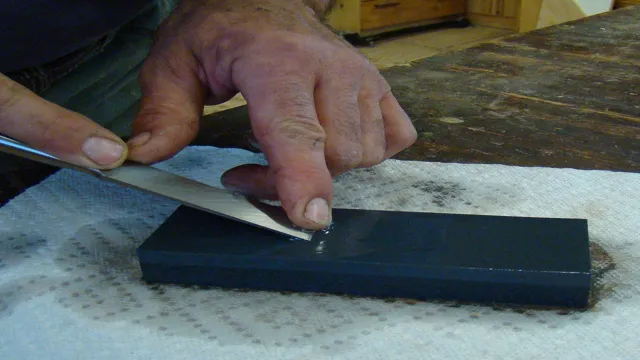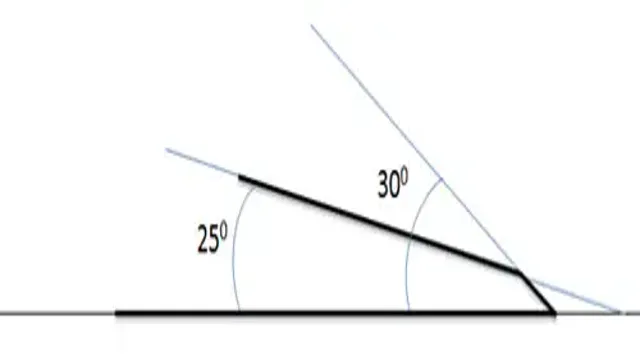Do you ever find yourself struggling to chisel away at a piece of wood, only to realize that your chisel is dull and ineffective? Fear not, as the solution to this problem is simple: sharpening your chisel to the right angle. A sharp chisel is essential for achieving clean cuts and making detailed designs. But, what is the right angle for sharpening a chisel, you may ask? The answer depends on the type of chisel you have and the task at hand.
In this blog, we will provide you with all the necessary information and tips on how to sharpen chisels and achieve the right angle. So, grab your chisels and let’s get started!
Understanding the Ideal Angle for Chisels
When it comes to sharpening chisels, the ideal angle depends on the type of chisel and its intended use. For general-purpose chisels, a bevel angle of 25 degrees is commonly used. This angle provides a good balance between sharpness and durability.
However, for tasks that require more precision, such as carving or paring, a bevel angle of 20 degrees may be more appropriate. For heavy-duty work, such as timber framing or chopping, a stronger bevel angle of 30 degrees or more may be necessary. It’s important to note that these angles are just guidelines and may need to be adjusted based on the specific chisel, material, and task at hand.
By experimenting with different angles, you can find the ideal one for your chisel and ensure optimal performance. So, when wondering what angle to sharpen chisels, consider the intended use and experiment until you find the perfect fit.
30-Degree Angle for Most Chisels
When it comes to woodworking, choosing the right angle for a chisel can make all the difference in the quality of your work. The ideal angle for most chisels is a 30-degree bevel. This angle provides a balance between sharpness and durability that allows the chisel to easily penetrate the wood while still maintaining its edge.
Choosing the proper angle can also prevent damage to your chisel or the wood you are working on. A sharper angle requires less force to be applied, reducing the risk of splitting the wood or damaging the chisel’s edge. On the other hand, a wider angle can be more durable and suitable for chopping thicker pieces of wood.
However, a wider angle can also make it harder to remove small amounts of material accurately. Overall, a 30-degree angle is the go-to for most chisels and provides a perfect balance of sharpness and durability for most woodworking projects.

25-Degree Angle for Bevel-Edge Chisels
When it comes to bevel-edge chisels, the ideal angle for the bevel is 25 degrees. But what does that mean, and why is it important? Essentially, the bevel angle refers to the angle at which the blade is ground, and it can have a big impact on how the chisel performs. A 25-degree angle strikes a good balance between sharpness and durability – a steeper angle may make the chisel sharper, but also more prone to damage, while a shallower angle may be stronger, but less effective at cutting.
It’s also worth noting that the angle may need to be adjusted depending on the job at hand – finer work may require a shallower angle, while heavier-duty tasks may require a sharper one. Ultimately, finding the right bevel angle for your chisels can take some trial and error, but it’s worth putting in the effort for cleaner, more precise cuts.
Methods to Achieve the Ideal Angle
When it comes to sharpening chisels, achieving the ideal angle can be crucial for achieving clean, precise cuts. Generally, a chisel should be sharpened to a 25-degree angle, but this can vary depending on the particular job and type of chisel being used. One method for achieving the ideal angle is to use a honing guide, which attaches to the chisel and ensures a consistent angle throughout the sharpening process.
Another method is to use a sharpening stone or sandpaper, holding the chisel at the desired angle and moving it in a circular or figure eight motion against the abrasive. Whichever method you choose, it is important to take your time and ensure that the angle is consistent throughout the entire blade. With practice, you’ll be able to sharpen your chisels to perfection, making your woodworking projects a breeze.
Using a Honing Guide
Using a honing guide is a popular method for achieving the ideal angle when sharpening tools. There are several ways to use a honing guide effectively, depending on the type of tool you are sharpening. One approach is to use a bevel angle gauge to determine the correct angle for your tool, and then set your honing guide to that angle.
Alternatively, some honing guides come with built-in angle settings, making it easy to achieve a consistent angle every time you sharpen. It’s important to remember that honing guides are only a tool, and practicing the proper technique is also crucial for achieving the best results. By using a honing guide in conjunction with a sharpening stone or other sharpening method, you can achieve a razor-sharp edge on your tools and keep them performing at their best.
Freehand Sharpening
Freehand sharpening is a valuable skill for any knife enthusiast to develop. By mastering the different methods of achieving the ideal angle, you can achieve razor-sharp edges on your blades. There are several ways to accomplish this, including using a sharpening stone, honing rod, or even a leather strop.
The trick is to find the method that works best for you and your particular knife. Some people prefer to use a guided sharpening system, but with a little practice, you can achieve excellent results with freehand methods. The key is to maintain a consistent angle throughout the sharpening process.
With time and patience, you can transform your dull knives into powerful cutting tools that will make your kitchen prep work a breeze. So, put in the effort to learn the skills required for freehand sharpening and take your cutting abilities to the next level!
Using a Sharpening Jig
Using a sharpening jig can be a game-changer for achieving the ideal angle in your knife sharpening process. There are several methods to choose from when using a sharpening jig, but the aim is always to create a consistent angle that ensures your blade is sharpened correctly. One method involves using a honing guide that attaches to the blade and sets the angle.
This method is ideal for beginners because it takes the guesswork out of the sharpening process. Another method is to use a bevel gauge that helps you measure the angle of your blade. This method is more advanced and requires more skill and experience, but it allows you to fine-tune the angle to your specific needs.
Whichever method you choose, using a sharpening jig can help you achieve consistent results that will improve your knife’s overall performance. So, don’t be afraid to give it a try and see the difference it makes!
Tips for Sharpening Chisels
One of the most important aspects of woodworking is having sharp chisels and knowing what angle to sharpen them at. Thankfully, sharpening chisels is a simple process that anyone can do with just a few basic tools. The first step is to determine the angle that your chisel is currently at, as this will dictate how you should sharpen it.
For most chisels, the ideal angle is between 25 and 30 degrees, but this can vary depending on the specific chisel and the type of wood you are working with. Once you know the angle you need to sharpen at, it’s just a matter of using a sharpening stone or sandpaper to hone the bevel to a razor-sharp edge. Make sure to maintain a consistent angle throughout the sharpening process, and take your time to ensure that you get the best possible edge.
With a little practice, you’ll soon be able to sharpen your chisels like a pro and tackle even the toughest woodworking projects with ease!
Inspect the Chisel Before Sharpening
Before you start sharpening your chisels, it’s important to take a good look at the tool itself. Inspecting the chisel beforehand can save you from any damage, frustration, or poor results while sharpening. Look for any chips, cracks, or rust that may affect the blade’s performance.
It’s also important to check for any debris, dirt, or other materials that may have accumulated on the tool. Cleaning and removing any buildup will make the sharpening process much more effective. Taking the time to thoroughly inspect and prepare your chisel before sharpening will ensure that it performs to the best of its ability and stays in good condition for longer as well.
So next time you go to sharpen your chisels, don’t skip this important step!
Use Proper Tool Maintenance
As a woodworker, using a chisel is essential, and maintaining its sharpness is equally important. It’s vital to avoid pressing a dull chisel as it can ruin your workpiece and potentially cause injury. One way to maintain your chisel is by sharpening it routinely.
Using a sharpening stone or sandpaper is a great way to start. Begin with a coarse grit, and then move up the grades to achieve a finer edge. It would be best if you also sharpened the back of the chisel to ensure it’s flat and square to the edges.
A sharpener’s honing guide is an excellent tool to achieve a consistent edge. Once the chisel is sharp and polished, it’s vital to keep it that way. By using a honing compound, you can achieve a mirror-like finish on your chisel, which will protect it from corrosion and further damage.
Maintaining and sharpening your chisels will also prolong their life, saving you money and the frustration of repetitive work. Remember, always wear protective gloves and keep your work area free of debris when working with sharp tools.
Conclusion
In the end, the perfect angle to sharpen chisels depends on a few key factors: the type of wood you’ll be working with, the type of chisel you have, and your own personal preference. Some people swear by a steep angle for greater precision, while others prefer a shallower angle for easier sharpening. But remember, just like with any DIY project, the most important thing is to find what works best for you and your specific needs.
So don’t be afraid to experiment, try new things, and most importantly, have fun with your sharpening!”
FAQs
What is the ideal angle for sharpening chisels?
The ideal angle for sharpening chisels is typically between 25-30 degrees.
What type of sharpening stone is best for sharpening chisels?
A diamond stone or water stone is best for sharpening chisels.
Can I use a bench grinder to sharpen chisels?
While it is possible to use a bench grinder to sharpen chisels, it is not recommended as it can easily overheat the chisel and ruin its temper.
How often should I sharpen my chisels?
It depends on how frequently you use your chisels, but it is recommended to sharpen chisels after every use or as soon as you notice dullness.
How can I maintain a consistent angle while sharpening chisels?
You can use a honing guide or sharpening jig to maintain a consistent angle while sharpening your chisels.
Can I sharpen chisels by hand?
Yes, you can sharpen chisels by hand, but it can be more difficult to maintain a consistent angle.
Are there any safety precautions I should take when sharpening chisels?
Yes, it is important to wear safety glasses and use a secure work surface when sharpening chisels to avoid injury.





